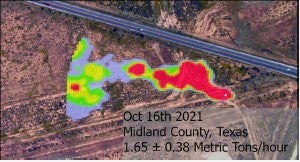By Erin Murphy and Jevan Yu
Methane emissions from pure fuel gathering pipelines within the U.S. Permian Basin are at the very least 14 occasions higher than Environmental Safety Company nationwide stock estimates, in keeping with new peer-reviewed analysis from EDF, Stanford College and the College of Arizona. Gathering traces transport unprocessed fuel from nicely websites to processing amenities and range extensively in dimension and stress, with diameters starting from two inches to as giant as 30 inches. Methane is a potent greenhouse fuel with over 84 occasions the warming potential of carbon dioxide over its first 20 years within the ambiance, and this new analysis signifies the significance of discovering and fixing pipeline methane leaks to mitigate the local weather disaster.
Methane emissions from gathering traces are increased than beforehand thought
After intensive surveys and subsequent evaluation, the analysis discovered quite a few giant gathering line leaks that endured over months and even years. As a part of EDF’s PermianMAP venture, oil and fuel infrastructure was surveyed in 4 aerial campaigns throughout 2019-2021 utilizing plane geared up with a sensor able to imaging and quantifying giant plumes of methane. The flights surveyed greater than 10,000 miles of gathering pipelines in every marketing campaign, figuring out a whole bunch of high-emitting pipeline sources.
Analysis exhibits gathering pipelines within the Permian Basin leaking 14 occasions extra methane than officers estimate Click on To Tweet
The dimensions of methane being launched from gathering traces is way increased than beforehand thought. The brand new examine finds that Permian Basin gathering line emissions are at the very least 213,000 metric tons per 12 months. This corresponds to an emission issue of two.7 metric tons per 12 months per kilometer of pipeline, which is 14 occasions higher than the U.S. EPA nationwide stock estimates. Making use of this estimate to all fuel gathering pipelines nationwide for illustrative functions would improve the EPA stock estimate for your complete pure fuel system by 27%.
These 213,000 metric tons of methane have the identical annual local weather affect as 3.7 million passenger autos and symbolize sufficient wasted fuel to fulfill the wants of two.1 million houses.
A small variety of leaks on gathering traces are chargeable for many of the methane emissions, like different segments of the oil and fuel provide chain, with about 15% of the most important leaks accounting for 50% of whole emissions detected. Thus, discovering and fixing a comparatively small variety of leaks might have important local weather advantages.
Notably, throughout the course of 4 survey campaigns throughout 2019-2021, the general methane emissions estimate dropped over time (whereas remaining persistently increased than prior nationwide estimates). EDF scientists sought to contact pipeline operators to offer details about recognized leaks throughout the campaigns, which might point out that operators acted on the data to handle methane leaks on their system and level to the worth of normal emission screening.
Gathering traces must be topic to leak survey and restore necessities
There may be an intensive community of over 435,000 miles of gathering traces within the U.S., however the overwhelming majority of those pipelines are nonetheless not topic to federal requirements for leak surveys and restore.
A landmark rule issued by the Pipeline and Hazardous Supplies Security Administration in Nov. 2021 established fundamental security requirements for an extra 90,000 miles of gathering traces, and for the primary time required annual reporting on all gathering traces. Beforehand solely about 10,000 miles of traces had been topic to federal leak survey and restore requirements, and the rule elevated that to over 30,000 miles. Whereas this progress is necessary, the overwhelming majority of gathering traces stay unregulated, which is insufficient to guard individuals and the surroundings.
The brand new analysis findings point out an pressing want to enhance oversight and upkeep of fuel gathering traces. Superior pipeline leak detection applied sciences and analytics, corresponding to these used for the examine, are available and supply a number of benefits to establish extra methane leaks.
Surveys have to cowl a big space to establish probably the most consequential leaks throughout prolonged, complicated gathering networks in distant areas, making aerial surveys simpler than autos on the bottom. Obtainable superior applied sciences present actionable knowledge in order that operators can’t solely find and repair the leaks, but in addition quantify reductions in methane emissions.
It’s important that PHMSA prioritize its superior leak detection rulemaking, which is required by the PIPES act of 2020 (Part 113) however has lately been delayed. And whereas the Act units a flooring—that the brand new rule ought to apply at minimal to gathering traces in closest proximity to individuals—the company ought to proceed to boost the bar to handle leaks throughout fuel gathering techniques. Particularly, PHMSA ought to improve its pipeline leak requirements by (1) requiring common leak surveys for all U.S. gathering traces and (2) requiring using aerial superior applied sciences.
These steps will cut back methane emissions and enhance the security of pipeline infrastructure, and this newest examine underscores the pressing want for such measures.







0 Comments